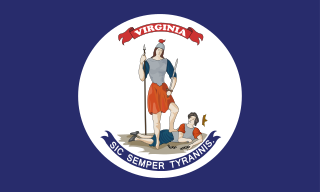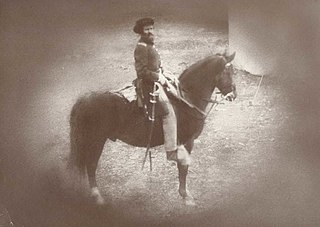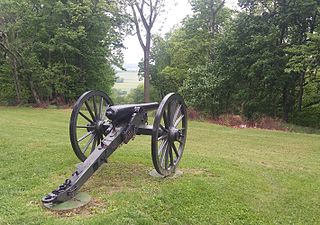| 8th Tennessee Cavalry Regiment | |
|---|---|
| Active | August 1863 to September 11, 1865 |
| Country | United States |
| Allegiance | Union |
| Branch | Cavalry |
| Engagements | Knoxville Campaign Battle of Blountsville Battle of Blue Springs Siege of Knoxville Battle of Morristown Battle of Bull's Gap Second Battle of Saltville |
The 8th Tennessee Cavalry Regiment was a cavalry regiment that served in the Union Army during the American Civil War.
The 8th Tennessee Cavalry was organized August 1863 at Camp Nelson, Kentucky, by consolidation of five companies that were organized June 30 through August 14, 1863, for the 10th Tennessee Cavalry and seven companies recruited at large in Tennessee for the 5th East Tennessee Cavalry. The regiment mustered in for a three-year enlistment under the command of Colonel Jesse H. Strickland, and was frequently referred to as the 5th East Tennessee Cavalry.
On February 6, 1864, the 10th East Tennessee Cavalry, which had failed to complete organization, was consolidated with the 8th Tennessee Cavalry and mustered under the command of Colonel Samuel K. N. Patton.
The regiment was attached to 2nd Brigade, 4th Division, XXIII Corps, Army of the Ohio, August–October 1863. 4th Brigade, 4th Division, XXIII Corps, to April 1864. 3rd Brigade, 4th Division, Cavalry Corps, Army of the Cumberland, to October 1864. 3rd Brigade, 4th Division, Cavalry Corps, Military Division Mississippi, to November 1864. District of East Tennessee, Department of the Cumberland, to March 1865. 3rd Brigade, Cavalry Division, District of East Tennessee, to July 1865. Cavalry Brigade, District of East Tennessee, to September 1865.
The 8th Tennessee Cavalry mustered out of service September 11, 1865, at Knoxville, Tennessee.
Skirmish, Hawkins County, August 1, 1863. Burnside's Campaign in eastern Tennessee August 16-October 17, 1863. Occupation of Knoxville September 2. Greenville September 11. Kingsport September 18. Bristol September 19. Carter's Depot September 20–21. Zollicoffer September 20–21. Watauga River Bridge September 21–22. Jonesboro September 21. Hall's Ford, on Watauga River, September 22. Blountsville, Johnson's Depot and Carter's Depot September 22. Blue Springs October 10. Henderson's Mill and Rheatown October 11. Zollicoffer October 12. Blountsville October 14. Bristol October 15. Knoxville Campaign November 4-December 23. Siege of Knoxville November 17-December 5. Duty at Knoxville, Greenville, Nashville and Columbia and patrol duty on line of Nashville & Chattanooga Railroad from Columbia to Nashville until August 1864. At Bull's Gap until October, 1864. Rheatown September 28. Watauga River September 29. Carter's Station September 30-October 1. Operations in eastern Tennessee October 10–28. Greenville October 12. Bull's Gap October 16. Clinch Mountain October 18. Clinch Valley, near Sneedsville, October 21. Mossy Creek and Panther Gap October 27. Morristown October 28. Russellville October 28. Operations against Breckenridge in eastern Tennessee November 4–17. Russellville November 11. Bull's Gap November 11–13. Russellville November 14. Strawberry Plains November 16–17. Flat Creek November 17. Stoneman's Saltville Raid December 10–29. Big Creek, near Rogersville, December 12. Kingsport December 13. Near Glade Springs December 15. Near Marion and capture of Wytheville December 16. Mt. Airey December 17. Near Marion December 17–18. Capture and destruction of salt works at Saltville December 20–21. Stoneman's Expedition from eastern Tennessee into southwest Virginia and western North Carolina March 21-April 25, 1865. Wytheville April 6. Shallow Ford and near Mocksville April 11. Salisbury April 12. Catawba River April 17. Swannanoa Gap April 22. Near Hendersonville April 23. Duty in District of East Tennessee until September 1865. [1]
The regiment lost a total of 280 men during service; 1 officer and 37 enlisted men killed or mortally wounded, 1 officer and 241 enlisted men died of accident or disease.
The 10th Michigan Cavalry Regiment was a cavalry regiment that served in the Union Army during the American Civil War.

The 11th Michigan Cavalry Regiment was a cavalry regiment that served in the Union Army during the American Civil War.
The 1st Kentucky Cavalry Regiment was a cavalry regiment that served in the Union Army during the American Civil War.
The 11th Kentucky Cavalry Regiment was a cavalry regiment that served in the Union Army during the American Civil War.
The 12th Kentucky Cavalry Regiment was a cavalry regiment that served in the Union Army during the American Civil War.
The 1st Tennessee Infantry Regiment was an infantry regiment that served in the Union Army during the American Civil War. Recruited from Tennessee Unionists, the regiment was organized in August 1861 and fought at Mill Springs in January 1862. The unit served in Sanders' Knoxville Raid, at Bean's Station, and Mossy Creek in 1863 as a mounted infantry unit. The regiment was dismounted and fought in the Atlanta campaign until it was withdrawn in August 1864. Subsequently, it performed garrison duty in East Tennessee until August 1865.
The 2nd Tennessee Infantry Regiment was an infantry regiment that served in the Union Army during the American Civil War.

The 5th Tennessee Cavalry Regiment was a cavalry regiment that served in the Union Army during the American Civil War. This regiment was originally recruited as the 1st Middle Tennessee Cavalry.
Battery E, 1st Battalion Tennessee Light Artillery was an artillery battery that served in the Union Army during the American Civil War. It originally mustered as Battery "D", 1st Tennessee Heavy Artillery, and as late as January 1864, it was referred to in reports as 1st East Tennessee Heavy Artillery.

The 64th Virginia Mounted Infantry Regiment was formed from troops raised in Lee, Scott, Wise and Buchanan counties in Virginia for service in the Confederate States Army during the American Civil War. It served as an infantry regiment, a cavalry regiment, and a mounted infantry (dragoon) unit, and had a mixed reputation.
The 13th Tennessee Cavalry Regiment was a cavalry regiment that served in the Union Army during the American Civil War. The regiment was originally designated 12th Tennessee Volunteer Cavalry, but was changed by order of Governor Andrew Johnson on December 31, 1863.
The 11th Tennessee Cavalry Regiment was a cavalry regiment that served in the Union Army during the American Civil War. The regiment was also known as 1st East Tennessee Cavalry Battalion and 11th East Tennessee Cavalry Regiment.
The 9th Tennessee Cavalry Regiment was a cavalry regiment that served in the Union Army during the American Civil War.
The 44th Ohio Infantry Regiment was an infantry regiment in the Union Army during the American Civil War. In early 1864, the regiment was reorganized into the 8th Ohio Cavalry Regiment.
The 2nd Ohio Cavalry Regiment was a cavalry regiment that served in the Union Army during the American Civil War.
The 9th Ohio Cavalry Regiment was a cavalry regiment that served in the Union Army during the American Civil War.
The 12th Ohio Cavalry Regiment was a cavalry regiment that served in the Union Army during the American Civil War.

The 5th Regiment Indiana Volunteer Cavalry was a cavalry regiment that served in the Union Army during the American Civil War.

Colvin's Battery Illinois Light Artillery was an artillery battery from Illinois that served in the Union Army during the American Civil War. The battery was organized in October 1863 and served in the Knoxville campaign. The battery campaigned in eastern Tennessee in January 1864 then garrisoned Knoxville for over a year. In March 1865, the unit was re-designed Battery K, 1st Illinois Light Artillery Regiment.

Battery M, 2nd Illinois Light Artillery Regiment was an artillery battery from Illinois that served in the Union Army during the American Civil War. The battery was organized in June 1862 at Springfield, Illinois. The unit was assigned to guard the railroad in West Virginia and was captured and paroled when Harpers Ferry surrendered in September 1862. After exchange, the battery took part in the Knoxville campaign in the fall and winter of 1863. The unit was stationed in Kentucky until it was mustered out in April 1864. Personnel were transferred to Battery C and Battery H, 2nd Illinois Light Artillery Regiment.